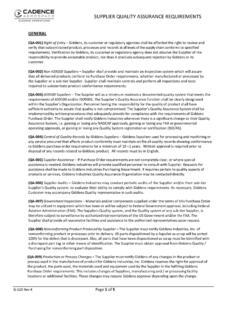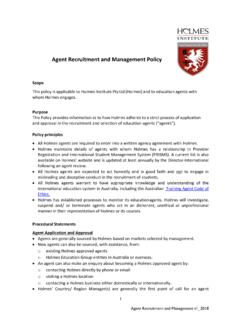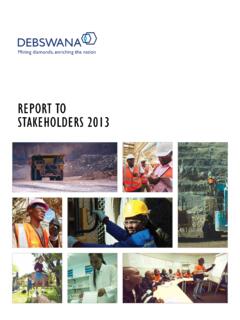Transcription of The Six Sigma Handbook, Third Edition - Moodlerooms
1 CHAPTER 4 Maximizing Resources The best Six Sigma projects begin not inside the business but outside it, focused on answer-ing the question: How can we make the customer more competitive? What is critical to the customer's success? Leaming the answer to that question and leaming how to provide the solution is the only focus we need. Jack Welch, CEO, General Electric This chapter addresses Six Sigma project selection and the management support activi-ties related to project success. Projects are the core activity driving change in the Six Sigma organization. Although change also takes place due to other efforts, such as Kaizen, project-based change is the force that drives breakthrough and cultural transformation. In a typical Six Sigma organization about 1 percent of the workforce is engaged full time in change activities, and each of these change agents will complete between three and seven projects in a year.
2 In addition there are another 5 percent or so part-time change agents, each of whom will complete about two smaller projects per year. The math-ematics translates to about 500 major projects and 1,000 smaller projects in an organiza-tion with 10,000 employees in any given year. Clearly, learning how to effectively deal with projects is critical to Six Sigma success. Choosing the Right Projects Projects must be focused on the right goals. This is the responsibility of the senior lead-ership, for example, the project sponsor, Executive Six Sigma Councilor equivalent group. Senior leadership is the only group with the necessary authority to designate cross-functional responsibilities and allow access to interdepartmental resources. Six Sigma projects will impact one of the major stakeholder groups: customers, sharehold-ers, or employees.
3 Although it is possible to calculate the impact of any given project on all three groups, I recommend that initially projects be evaluated separately for each group. This keeps the analysis relatively simple and ensures that a good stakeholder mix is represented in the project portfolio. Types of Projects Customer Value Projects Many, if not most Six Sigma projects are selected because they have a positive impact on customers. To evaluate such projects one must be able to determine the linkage between 117 118 Chapter Four business processes and customer-perceived value. Chapter 2 discussed how to create organizations that are customer-driven, which is essentiaL Customer-driven organizations, especially process enterprises, focus on customer value as a matter of routine. This focus will generate many Six Sigma customer value projects in the course of strategy deployment.
4 However, in addition to the strategy-based linkage of Six Sigma projects described in Chap. 2, there is also a need to use customer demands directly to generate focused Six Sigma projects. The techniques for obtaining this linkage are the same as those used in Chap. 2. The difference is that the focus here is not on strategy deploy-ment or budgeting, but on Six Sigma improvement projects focused on specific cus-tomer demands. Learning what customers value is primarily determined by firsthand contact with customers through customer focus groups, interviews, surveys, etc. The connection between customer-perceived value and business processes, or "customer value streams," is established through business process mapping (see Chap. 6 and 7) and quality function deployment (QFD). The Executive Six Sigma Council and project spon-sors should carefully review the results of these efforts to locate the "lever points" where Six Sigma projects will have the greatest impact on customer value.
5 Shareholder Value Projects Six Sigma provides a "double-whammy" by addressing both efficiency and revenues. Revenue is impacted by improving the customer value proposition, which allows organizations to charge premium prices for superior quality, or to keep prices com-petitive and increase sales volume and market share due to superior quality. Improved efficiency is achieved by reducing the cost of poor quality, reducing cycle time, or eliminating waste in business processes. To determine which Six Sigma projects address the issue of business process efficiency evaluate the high-level business pro-cess maps (including SIPOC) and flow charts. Other Six Sigma Projects Some Six Sigma projects address intangibles, such as employee morale, regulatory con-cerns, or environmental issues. These projects can be just as important as those which address customer or shareholder value.
6 Analyzing Project Candidates You now have a list of candidate Six Sigma projects. Assuming that the organization has limited resources, the next task is to select a subset of these projects to fund and staff. Projects cost money, take time, and disrupt normal operations and standard rou-tines. For these reasons projects designed to improve processes should be limited to processes that are important to the enterprise. Furthermore, projects should be under-taken only when success is highly likely. Feasibility is determined by considering the scope and cost of a project and the support it receives from the process owner. In this section a number of techniques and approaches are presented to help identify those projects that will be chosen for Six Sigma . Benefit-Cost Analysis Benefit-cost analysis can be as elaborate or as simple as the magnitude of the project expenditures demands.
7 The Six Sigma manager is advised that most such analyses are M a x i m i z i n g Res 0 U r c e s 119 easier to "sell" to senior management if done by (or reviewed and approved by) experts in the finance and accounting department. The plain fact is that the finance department has credibility in estimating cost and benefit that the Six Sigma department, and any other department, lacks. The best approach is to get the finance department to conduct the benefit-cost analysis with support from the other departments involved in the project. We will provide an overview of some principles and techniques that are useful in benefit-cost analysis. A fundamental problem with performing benefit-cost analysis is that, in general, it is easier to accurately estimate costs than benefits. Costs can usually be quantified in fairly precise terms in a budget.
8 Costs are claims on resources the firm already has. In contrast, benefits are merely predictions of future events, which mayor may not actually occur. Also, benefits are often stated in units other than dollars, making the comparison of cost and benefit problematic. The problem is especially acute where quality improvement projects are concerned. For example, a proposed project may involve placing additional staff on a customer "hot line." The cost is easy to compute: X employees at a salary of $Y each, equipment, office space, supervision, etc. The benefit is much more difficult to determine. Perhaps data indicate that average time on hold will be improved, but the amount of the improvement and the probability that it will occur are speculations. Even if the time-on-hold improvement were pre-cise, the impact on customer satisfaction would be an estimate.
9 The association between customer satisfaction and revenues is yet another estimate. Despite these difficulties, reasonable cause-and-effect linkages can be established to form the basis for benefit-cost analysis. To compensate for the uncertainties of estimating benefits, it makes sense to demand a relatively high ratio of benefit to cost. For example, it is not unusual to have senior leadership demand a ROI of 100% in the first year on a Six Sigma project. Rather than becoming distressed at this "injustice," the Black Belt should realize that such demands are a response to the inherent difficulties in quanti-fying benefits. Types of Savings The accounting or finance department should formally define the different categories of savings. Savings are typically placed in categories such as: Hard savings are actual reductions in dollars now being spent, such as reduced bud-gets, fewer employees, reduction of prices paid on purchasing contracts, and so on.
10 Hard savings can be used to lower prices, change bid models, increase profits, or for other purposes where a high degree of confidence in the benefit is required. Soft savings are projected reductions that should result from the project. For exam-ple, savings from less inventory, reduced testing, lower cycle times, improved yields, lower rework rates, and reduced scrap. It is important that savings be integrated into the business systems of the organiza-tion. If the institutional framework doesn't change, the savings could eventually be lost. For example, if a Six Sigma project improves a process yield, be sure the MRP system's calculations reflect the new yields. A System for Assessing Six Sigma Projects Assessing Six Sigma projects is an art as well as a science. It is also critical to the success of Six Sigma , and to the individual Black Belt.









